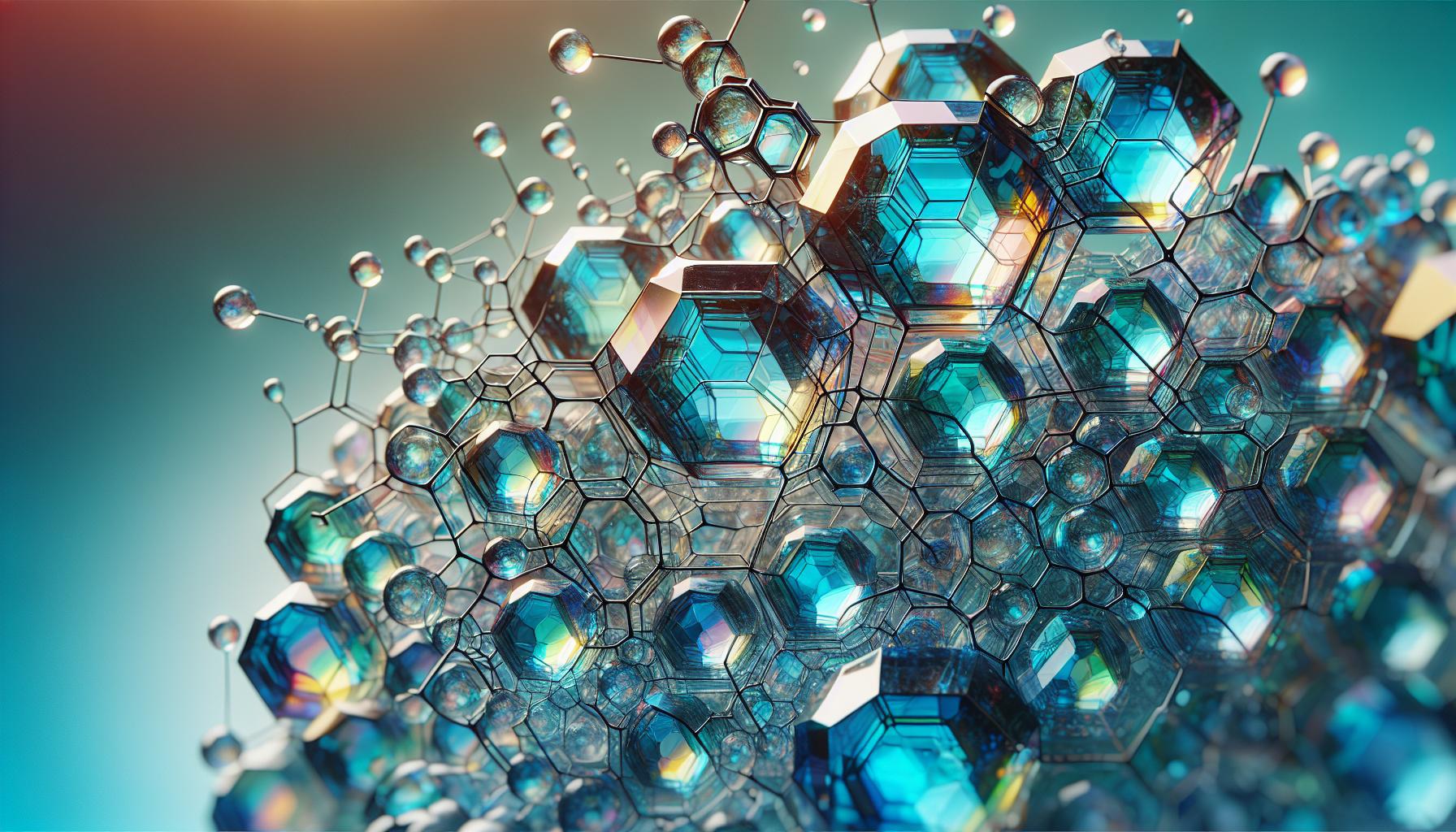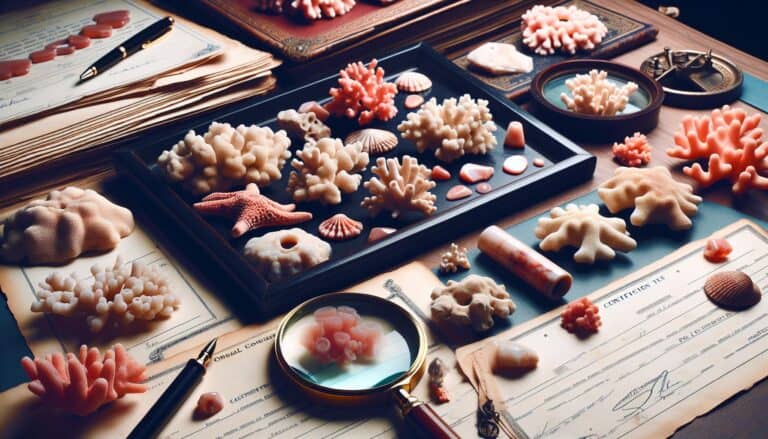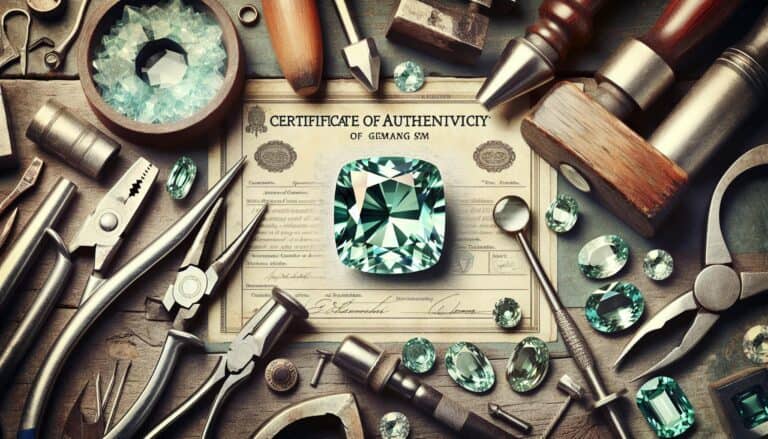Diving into the world of gemstones, you’ve likely heard of aquamarine, the serene blue treasure that evokes the purity of crystalline waters.
It’s not just the color that’s captivating; this gem has a rich history and is beloved for its stunning clarity and fine cuts.
But how can you tell if you’ve got the real deal or just a convincing imitation? Fear not, because identifying authentic aquamarine is simpler than you might think.
With the right knowledge, you’ll be able to spot the genuine article with confidence.
To identify genuine aquamarine, check for its light blue to greenish-blue color, examine for natural inclusions, and perform a hardness test (7.5-8 on the Mohs scale). Aquamarine won’t attract magnets and should show birefringence. It has a specific gravity of 2.68-2.74 and leaves a white streak.
How to Identify Aquamarine Through Testing
Visual Inspection
Start with a close look at color and clarity. Authentic aquamarines boast a light blue to deep blue-green color. Hold the stone up to the light and check for inclusions. Small, natural imperfections can signal a real gem, whereas a completely flawless stone might be a synthetic.
The Streak Test
Scratch the gemstone along a piece of unglazed porcelain tile. A true aquamarine will leave a white streak behind. Remember, this test can damage the stone and should be done with caution.
Magnet Test
Aquamarine doesn’t contain magnetic minerals, so it won’t react to a magnet. If your gemstone is attracted to the magnet, it’s likely a fraud.
Hardness Test
With a hardness rating of 7.5 to 8 on the Mohs scale, aquamarine can scratch glass. Try using the stone to mark a piece of glass. If it leaves a scratch without any damage to itself, it’s a strong sign of authenticity.
Birefringence Test
Aquamarines exhibit birefringence, which can be seen as a doubling of lines or edges when viewed through a loupe. This dual-image effect won’t be present in glass imitations.
Checking The Diaphaneity
Examine the gem’s diaphaneity – its transparency or translucence. Real aquamarine is transparent with only slight inclusions, if any.
Single or Double Refraction
Like other beryl, aquamarine typically shows double refraction, where light splits into two paths as it passes through the crystal. This feature helps distinguish it from single-refractive synthetic counterparts.
Refractive Index Test
A refractometer measures the stone’s refractive index. Genuine aquamarine has a refractive index ranging from 1.567 to 1.590. Ensure the stone is clean for an accurate reading.
Finding The Specific Gravity
Aquamarine’s specific gravity is around 2.68 to 2.74. This can be measured using a hydrostatic balance or heavy liquids. This test should be done by a professional to avoid harming the gemstone.
Identifying Aquamarines in the Field
Look for stones in regions known for aquamarine, like Brazil or Africa. Check for characteristic hexagonal crystal shapes and a glossy surface—tell-tale signs of aquamarine deposits.
Recognizing Potential Aquamarine Rocks
When hunting for aquamarine in the field, look for rocks with cavities or pegmatites. These large crystal formations often house gemstones and can be a sign that aquamarines are near.
Physical Characteristics of Aquamarine

Aquamarines stand out from other gemstones due to their distinct properties. Originally from the beryl family, these stones embody a hardness of 7.5 to 8 on the Mohs scale, meaning they’re quite durable and resistant to scratching. This characteristic allows jewelers to craft intricate designs without fear of damaging the gem.
When inspecting aquamarines, you’ll notice their glass-like luster, which contributes to their coveted aesthetic. The stones exhibit a translucent to transparent diaphaneity, allowing light to pass through and enhancing their mesmerizing blue to blue-green hues. Colors can range from a faint, almost clear, blue to deeper shades, with the most valuable aquamarines showing a rich, sky-blue color.
The crystal structure of aquamarine is usually hexagonal, which can influence the gem’s outward shape and facets. Inclusions are common but often difficult to spot without magnification. If present, these inclusions can provide clues about the stone’s authenticity, as natural aquamarines typically contain long, hollow tubes, while synthetic ones may not.
Keep in mind that the density of aquamarine is another indicator of its identity. Specific gravity tests often reveal values between 2.68 to 2.74, helping you discern real aquamarines from imitations.
In the field, recognizing these physical characteristics can make your search for genuine aquamarines much more productive. Keep an eye out for their signature blue hues and hexagonal crystal habits, especially in areas where beryl minerals are known to form. With these insights, you’re well on your way to becoming an expert in identifying true aquamarine gems.
How Are Aquamarine Formed?
Aquamarine gemstones are formed through a fascinating geological process that takes millions of years. Understanding this formation process can further aid in identifying genuine stones.
Aquamarine is a variety of the mineral beryl and is crystallized from silicate mineral solutions. These solutions are often rich in beryllium and under high pressure and temperature conditions deep within the Earth’s crust.
- Pegmatites, which are igneous rocks, often house these gemstones.
- Hydrothermal vents are another common source for aquamarine formation where mineral-laden water deposits crystals as it cools.
Over time, these conditions allow aquamarine crystals to grow while incorporating other elements like iron, which contributes to their blue-green color. Optimal conditions for their growth include:
- High temperatures conducive to dissolving minerals
- Low to moderate pressure environments
- Ample space within rock cavities
The unique hexagonal crystal structure of aquamarine is a direct result of the beryl composition under these specific geologic conditions. As you encounter aquamarine in various settings, remember that their formation is a clue to their authenticity. Large, clear crystals are indicative of slow cooling, which is typical for natural beryl formation, unlike rushed synthetic processes.
When examining aquamarine samples, observe for irregularities and variations that are indicative of natural formation. Each stone tells a story of its long journey from deep within the Earth to the surface, where it may ultimately be set into jewelry or held as a collector’s specimen.
Preparation for Aquamarine Hunting
Before you embark on your journey to uncover the hidden treasures of aquamarine, it’s vital to gear up appropriately. Aquamarine hunting can be an exhilarating adventure, but being unprepared is surely not an option. You wouldn’t dive into the ocean without a snorkel, would you? The same goes for aquamarine hunting—equip yourself for success.
Gathering the Right Tools
To increase your chances of finding genuine aquamarine stones, you’ll need a set of specific tools designed for gem hunting. Here’s a list of must-have equipment to help make your search both efficient and rewarding:
- Geologist’s hammer: Essential for breaking rocks and extracting potential gemstones.
- Chisel and gloves: Used for prying stones from their host rocks while protecting your hands.
- Magnifying glass or jeweler’s loupe: Allows for close inspection of minerals on the spot.
- Field guide: A good field guide is invaluable, helping you identify different minerals and providing insights into local geology.
- Portable electronic scale: To measure the specific gravity of stones, which is a key identifier for aquamarine.
- UV light: Some minerals have a characteristic fluorescence under UV light; this can be a handy tool in differentiation.
- Tweezers: To handle small stones and examine them more closely without losing them.
Remember, while some of these tools are for identification, others are for safely extracting the stones from their natural environments.
Safety Considerations
Your safety is paramount during your aquamarine hunting excursions. Here are important safety measures to adhere to:
- Wear protective gear: Safety glasses and durable gloves are non-negotiable. They’ll protect you from flying rock fragments and sharp edges.
- Sturdy footwear: Hiking boots with good grip are necessary to navigate uneven terrain safely.
- Weather-appropriate clothing: Be ready for sudden weather changes by dressing in layers.
- First aid kit: Always have a basic first aid kit handy for any minor injuries.
- Let someone know: Before heading out, inform someone about your planned location and return time.
- Be mindful of your environment: Stay aware of potential hazards like loose rocks, steep slopes, and wildlife.
- Map and compass or GPS: Ensure you can navigate your way through remote areas and back.
Handling and Care of Found Aquamarine

Once you’ve had a successful hunt and have your aquamarines, it’s crucial to handle and care for them properly. This will ensure your treasures maintain their beauty and value.
Cleaning Aquamarines
Before you tuck your aquamarines away, you’ll want to clean them. Start by using a soft brush and lukewarm water. Avoid harsh detergents, as these can damage the stone. If needed, a mild soap can be used, but be sure to rinse thoroughly to prevent residue buildup.
Here’s a step-by-step guide to cleaning your aquamarines:
- Rinse your gem in lukewarm water to remove loose dirt.
- Gently brush with a soft-bristled brush, like a toothbrush.
- If using soap, choose a mild variety and apply it sparingly.
- Brush the stone again, focusing on crevices or areas with clinging dirt.
- Rinse the aquamarine under a stream of warm water to wash away soap.
- Dry your stone with a soft, lint-free cloth and let it air dry completely.
Storing Aquamarines
Proper storage is key to protecting your aquamarines. Soft pouches or fabric-lined boxes are ideal. Keeping them wrapped in a soft cloth is also a safe bet. You’ll want to ensure that your aquamarines aren’t stored with other harder gemstones that might scratch them, given their Mohs hardness rating of 7.5 to 8.
Here are some additional tips for storing your aquamarines securely:
- Keep each stone in an individual bag or compartment to avoid scratches.
- If you’re using a box, make sure the compartments are soft and padded.
- Don’t store aquamarines in direct sunlight, which can cause the color to fade over time.
- If you’ve got a sizable collection, consider investing in a gemstone storage case designed to protect and organize your stones.
- For long-term storage, place a silica packet in with your aquamarines to prevent moisture buildup that could lead to mildew or discoloration.
Handling and caring for your aquamarines with the right methods not only preserves their luster and value but also extends their life span for generations to enjoy. With the right approach, your quest for the perfect aquamarine can result in a collection that remains as captivating as the day you found it.
Conclusion: Confirming Aquamarine is Real
You’ve got all the tools and knowledge you need to identify genuine aquamarine.
Remember, it’s about observing the subtle details: the hue, clarity, and unique physical properties that set this gemstone apart. With your geologist’s hammer in hand and safety gear in place, you’re ready to embark on your aquamarine hunting adventure. Care for your treasures with gentle cleaning and mindful storage to preserve their splendor. Armed with these insights, you’re well-equipped to confirm the authenticity of aquamarine, ensuring your finds are as valuable as they are beautiful.
Happy hunting!







